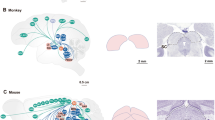Abstract
Responses of single neurons in the vestibular nerve to high-intensity clicks were studied by extracellular recording in anaesthetised guinea pigs. One hundred and two neurons in the posterior division of the superior branch or in the inferior branch of the vestibular nerve were activated at short latency by intense clicks. The latency of activation was short (median 0.9 ms) and the threshold was high: the click intensity for evoking the response of these cells was around 60 dB above the auditory brainstem response threshold. Animals were tilted and rotated to identify physiologically the sensory region of the labyrinth from which the activated neurons originated. Seventeen neurons responded to static tilt as well as clicks. These results show that vestibular receptors, probably the otoliths, respond to clicks at intensities corresponding to those used in a new clinical test of the vestibulo-collic pathway.
Similar content being viewed by others
References
Cazals Y, Aran J-M, Erre J-P, Guilhaume A (1980) Acoustic responses after total destruction of the cochlear receptor: brainstem and auditory cortex. Science 210:83–86
Cazals Y, Aran J-M, Erre J-P (1982) Frequency sensitivity and selectivity of acoustically evoked potentials after complete cochlear hair cell destruction. Brain Res 231:197–203
Cody DTR, Jacobson JL, Walker JC, Bickford RG (1964) Averaged evoked myogenic and cortical potentials to sound in man. Ann Otol Rhinol Laryngol 73:763–777
Colebatch JG, Halmagyi GM, Skuse NF (1994) Myogenic potentials generated by a click-evoked vestibulocollic reflex. J Neurol Neurosurg Psychiatr 57:190–197
Colebatch JG, Rothwell JC, Bronstein A, Ludman H (In press) Click-evoked vestibular activation in the Tullio phenomenon. J Neurol Neurosurg Psychiatr
Curthoys IS (1981) Scarpa's ganglion in the rat and guinea pig. Acta Otolaryngol (Stockh) 92:107–113
Curthoys IS (1982) The response of primary horizontal semicircular canal neurons in the rat and guinea pig to angular acceleration. Exp Brain Res 47:286–294
Dallos P, Harris D, Özdamar Ö, Ryan A (1978) Behavioral, compound action potential, and single unit thresholds: relationship in normal and abnormal ears. J Acoust Soc Am 64:151–157
Didier A, Cazais Y (1989) Acoustic responses recorded from the saccular bundle on the eighth nerve of the guinea pig. Hearing Res 37:123–128
Dieterich M, Brandt T, Fries W (1989) Otolith function in man. Results from a case of otolith Tullio phenomenon. Brain 112:1377–1392
Fernández C, Goldberg JM (1976) Physiology of peripheral neurons innervating otolith organs of the squirrel monkey. I. Response to static tilts and to long-duration centrifugal force. J Neurophysiol 39:970–984
Fullerton BC, Levine RA, Hosford-Dunn HL, Kiang NYS (1987) Comparison of cat and human brain-stem auditory evoked potentials. Electroencephalogr Clin Neurophysiol 66:547–570
Gacek RR (1969) The course and central termination of first order neurons supplying vestibular endorgans in the cat. Acta Otolaryngol (Stockh) [Suppl] 254:1–66
Goldberg JM, Fernández C (1977) Conduction times and background discharge of vestibular afferents. Brain Res 122:545–550
Goldberg JM, Minor LB, Fernández C (1988) The functional organization of the vestibular labyrinth and of some of its central pathways. In: Hwang JC, Daunton NG, Wilson VJ (ed) Basic and applied aspects of vestibular function. Hong Kong University Press, Hong Kong, pp 3–12
Gstoettner W, Burian M (1987) Vestibular nuclear complex in the guinea pig: a cytoarchitectonic study and map in three planes. J Comp Neurol 257:176–188
Kiang NYS, Watanabe T, Thomas EC, Clark LF (1965) Discharge patterns of single fibres in the cat's auditory nerve. MIT Press, Cambridge
Murofushi T, Kaga K, Asakage T (1994) Temporary latency shifts in auditory evoked potentials by injection of lidocaine in the rat. Hearing Res 76:53–59
Pralong D, Carlile S (1994) Measuring the human head-related transfer functions: a novel method for the construction and calibration of a miniature “in-ear” recording system. J Acoust Soc Am 95:3435–3444
Wada S, Starr A (1983) Generation of auditory brain stem responses (ABRs). I. Effects of injection of a local anesthetic procaine HCl into the trapezoid body of guinea pigs and cat. Electroencephalogr Clin Neurophysiol 56:326–339
Young ED, Fernández C, Goldberg JM (1977) Responses of squirrel monkey vestibular neurons to audio-frequency sound and head vibration. Acta Otolaryngol (Stockh) 84:352–360
Author information
Authors and Affiliations
Rights and permissions
About this article
Cite this article
Murofushi, T., Curthoys, I.S., Topple, A.N. et al. Responses of guinea pig primary vestibular neurons to clicks. Exp Brain Res 103, 174–178 (1995). https://doi.org/10.1007/BF00241975
Received:
Accepted:
Issue Date:
DOI: https://doi.org/10.1007/BF00241975




